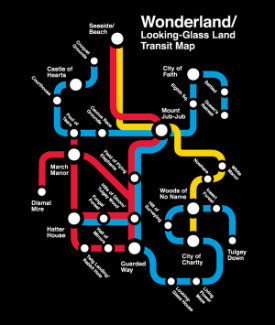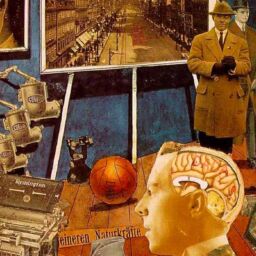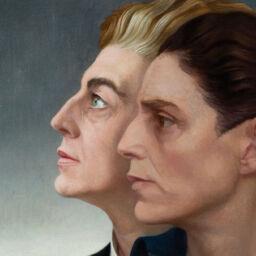
The Map vs. the Territory of Type
Kartik Subbarao, November 1, 2012

For different people and different situations, “holding the type map rigidly” can look and feel different. Intuition may prompt us to overgeneralize the map and draw unwarranted inferences. Sensing may make us hyperliteral about personality type characteristics. Feeling may hijack personality type to amplify and justify prejudices. Thinking may stereotype and put everyone in a box. Although we may grab for the hammer in different ways at different times, whenever we do, we tend to feel heavy inside and look more awkward to others. By contrast, when we hold the map lightly, we tend to feel lighter inside and look more graceful to others.
Personal Lessons in Map Holding
For me, learning about the MBTI® and Jungian personality theory was like getting polarized sunglasses. I could suddenly see crisp, well-demarcated lines where previously I could only make out amorphous blobs amidst a hazy glare. As someone with ENTP preferences, when I first learned about extraverted intuition, I could suddenly draw a box around this dominant aspect of my ego and start treating it like an object. I could see how it informed my experience in so many ways, and how it contrasted with the function preferences of others. Reading firsthand accounts of similarly illuminating experiences from several people reinforced the impression that I was onto something important.
Like many of us who hit upon type in this way, I became an aggressive cartographer, looking for the typological implications in all sorts of situations. I asked many people I knew to fill out MBTI questionnaires and quizzed them about their personality type. In type discussion forums (and elsewhere), I used type terminology to make bold assertions about the underlying causes of various behaviors. I earnestly engaged in debates about the personality types of famous people and even fictional characters. I tried to introduce type concepts in my workplace. Essentially, I was trying to pin down type in the form of externally-observable characteristics/patterns that would be absolutely predictive.

Another problem was that the more detail I filled in on my type map, the less useful it became to me in some situations. Instead of suggesting new solutions to interpersonal conflict, it simply piled on more reasons for why the challenges were hopelessly insurmountable. (E. g.: “Not only do their dominant functions conflict, but their auxiliary functions do too!”) Like writing on the cramped surface of an uninflated balloon, the space just wasn’t there to maintain depth, context, and perspective among the details. And so my ability to extract useful insights from personality type reached somewhat of a plateau.
In 2000, I was working in a corporate Information Technology organization as the lead architect/engineer for a company-wide IT service. To implement some of my particularly ambitious ideas for improving the service, I needed the cooperation of other IT teams. The problem was the objections raised by a group of people I had typed at the time as NTJs. They cited a number of flaws in my ideas, which struck me as trivial or irrelevant in practice, missing what I saw as the larger picture. Throughout these debates, their comments were often couched in distancing language. For instance, they would sometimes respond with, “That’s not company policy,” which was particularly maddening since I felt that as fellow NTs, they should be able to explain their reasoning from first principles. No matter how clear and transparent I was about my objectives and the approaches I preferred vs. disliked, they would never reciprocate and tell me something like, “I don’t like approach ‘X’ for ‘A’ reason and I’d rather pursue ‘Y’ instead for ‘B’ reason.” It also didn’t matter much whether I was especially diplomatic or not—either way, the result was often stalemate.
I knew that there was a type clash (which I characterized as an NTP/NTJ conflict between my flexible/evolutionary approach and their structured/planned approach), but I didn’t know what to do about it. I’d had other positive interactions with these folks, so I knew they were smart people with good motivations. I wanted to forge a collaboration where the diversity of our types became a benefit, as opposed to a hindrance. So I gave considerable thought to pitching a facilitated shared-visioning workshop to management, that would explore common goals, surface the personality type issues that exacerbated this conflict, and work towards a better level of communication and understanding. I thought that just exposing these people to type concepts might be powerful enough to break the logjam in our interactions. But even if we had been able to arrange the workshop, that would have been only the start, not the end, of the process.
After a decade of growth, a lot of things are clearer to me now. For starters, typecasting these people as NTJs may have been way off the mark. They certainly provided very convenient hooks for me to project Ni and Te, but that didn’t necessarily make them NTJs. This typecasting led me to expect them to behave in certain ways, and when they didn’t behave according to script (e.g., their unwillingness to explain their reasoning from the fundamental principles that I assumed were at the root of their objections), I became frustrated. A type-savvy visioning workshop might have helped somewhat, but there too, I think I was implicitly expecting a lot of magic to happen. There’s a classic cartoon where a character walks off a cliff and remains suspended in mid-air. He then takes out a book on the law of gravity and starts to read—whereupon he immediately plummets to the ground. I wonder if I was expecting my colleagues to learn about the ‘laws’ of personality theory and then suddenly start conforming to them. Or maybe I expected that the powerful vocabulary of type would instantly transform their thinking and get them to understand me. I was holding on to the personality type map very rigidly, requiring it to deliver an objectively irrefutable explanation of the problem, along with a clear solution that would inevitably be accepted. And the more intently I framed the problem using type language, the less room I had to see it from other perspectives.
What I needed most wasn’t for my colleagues to go through a personality type workshop and see the light. What I needed was more room in my mind to contain multiple and opposing perspectives. With this room, I would have been able to relate to and connect with their comments more attentively, and be less triggered by their objections. I would have heard more of what they were saying, and made better sense of their implicit communication—what they weren’t saying. Collectively, that would have given me a much better picture of where they were coming from, even if they couldn’t or wouldn’t spell it out for me the way I wanted to hear it. I’d then be able to discern whether there was a real opportunity for collaboration underlying the points of contention, or whether our worldviews were just too far apart. In the former case, I could apply insights from personality type as they naturally occurred to me to facilitate the work, without forcing anything. For example, I might have observed that I was doing most of the talking, and created more space for others to express their views; or I might have noticed that I was putting people on the spot, and enabled them to take more time to respond offline. In the latter case, personality type would remind me to honor differences, not to expect more than is realistically possible, and to redirect my energies into more suitable channels. In both cases, the pressure would be off the theory to work any magic—and whatever magic did happen could be appreciated without expectation.
Although I can simultaneously hold more perspectives today, and hold the personality type map more lightly than I could ten years ago, it is very much a work in progress. There are plenty of times when I catch myself grabbing on to the type map (and other maps for that matter). While unsettling at times, I’ve come to see it as a normal experience in the mapmaking process. We shouldn’t underestimate the power of this knowledge. Many of us will come to prize it highly, and expect things from it that it can’t possibly deliver. We can also become very proud of our type—after all, a positively framed description of our type is a custom-tailored ego booster! So it seems natural that some amount of disillusionment will be experienced as these intense projections are reclaimed.
Holding the Map in the IT Workplace
In a 2010 article in IT Professional, Luiz Fernando Capretz and Faheem Ahmed present a series of mappings of various IT jobs (System Analyst, Software Designer, and others) to skills required in those jobs (communication skills, interpersonal skills, analytical/problem-solving skills, and others), to the MBTI preferences (E-I-N-S-T-F-J-P) that they predict as excelling in those skills. Before commenting on their recommendations, I’d like to say that I fully support their underlying motivations for pursuing this research:
This interdisciplinary human-centered research incorporates theories about psychological types, human factors, and software engineering. It contributes toward a bridge that links software engineering and software psychology. (p. 6)
We do need more interdisciplinary research, and the authors are making a genuine effort to contribute to this process.

If the language and conceptual issues are cleaned up, and if the conclusions are supported with empirical data, there’s probably a workable framework in there. IT workers familiar with their personality type might be exposed to new career possibilities that appeal to them; or on the flip side, they might gain additional insight into why their current job is particularly draining to them.
There is a risk of overreaching though, if, through typological zeal, managers wield this kind of framework too heavily—if they take the disciplined set of principles and rules that type brings to the study of personality, and apply them dogmatically. For example, a manager mandating that all of his system analysts be EF types would be problematic in a number of ways. For starters, all of the highly skilled non-EF system analysts would be precluded from doing work at which they excel. Secondly, EFs who have no interest in systems analysis will find themselves with limited alternate options, and may end up in systems analysis jobs that they really don’t enjoy. In this situation, it’s only a matter of time before employees start to game the personality tests—which undermines the system and worse, erodes trust inside the organization. It’s hard to see how any organizational gains would not be offset by these significant downsides.
When we hold the type map more lightly though, we can get a lot more out of this kind of framework. First, we must be comfortable with setting aside type terminology/jargon and using more conventional language when necessary. Peter Senge puts this well in The Dance of Change:
One’s own jargon is hard to recognize because it is always “in the eye of the beholder.” Once new terms and idioms become used regularly within a team, team members come to take them for granted. Then, when they use these terms with others, they are unaware that they are “speaking in tongues” as far as the uninitiated are concerned. This is why developing awareness of one’s language is a high leverage strategy… . It is also why explaining complex ideas in the most simple and accessible manner has always been a hallmark of great leadership. (1999, p. 333)
The jargon of personality theory, like that of systems thinking and other psychologically complex domains, is readily interpreted in different ways, based on the knowledge and awareness of the listener. So it’s important for us to be able to unpack our highly technical comments when we’re trying to get alignment and clarity with others.

While I was considering various ways to effectively apply the IT jobs framework, I happened to come across this observation from Bob McAlpine in a LinkedIn discussion forum:
I have found enough times that demonstrated skills didn’t match [type] preferences to be afraid of using preferences to screen applicants in the hiring process. What I ask people to do is analyze their job requirements using the function-attitudes, then design a behavioral interview to determine if the applicant possesses the skill. Using this method I can use type theory without ever administering an instrument or trying to determine a person’s type code.
I think this approach could add considerable value to the IT jobs framework. Instead of forcing personality type to be the lone output of the process (i.e. what types are allowed to apply for a given job), allow it to be an input (i.e. how do the function-attitudes inform us about specific competencies that may be present in the pool of applicants). Don’t force-fit type terminology into the interview process itself; at that time, focus on skills and behaviors derived from the type-aware prework. For example, a hiring manager might review a description of introverted intuition (Ni), such as the following excerpt from Functions of Type by Gary and Margaret Hartzler:
[Introverted intuition] often sees ideas simultaneously from several perspectives … . For example, if several people are involved in a discussion, [introverted intuition] is able to see the various points of view, virtually simultaneously. (2005, p. 28)
They offer the following as one of the exercises for developing introverted intuition:
Look at embedded figures (such as the well-known two-faces/vase image) and practice changing your perception (perspective) back and forth between the two images. See how quickly you can get yourself to change perspective. (2005, p. 30)
If the manager needs to hire an Application Programming Interface (API) designer, this kind of perspective-awareness might jump out as being highly relevant. (Essentially, an API defines a programmer’s conventional ‘perspective’ for interacting with a complex software system.) So during the interview, the manager can describe a software system to the applicant and ask him or her to design an API for that system. After that, the manager can immediately ask the applicant to design an entirely different API for the same system and observe the response. Is the applicant easily able to shift between the previous perspective and the new one? Can the applicant readily discuss the pros and cons of both approaches? The hiring manager doesn’t have to mention anything about personality type in this discussion. It doesn’t matter if the applicant’s type preference has Ni in a dominant, auxiliary, or any other position.
Over time, high performers could be interviewed to gain further insights—such as the commonalities and differences between the approaches of INTP system analysts and ESFJ system analysts to their jobs. By sharing this information throughout the organization, employees can get a better picture of how success in each job looks and feels like from the inside. In general, the idea is to allow type to surface in an advisory/informative role, rather than a prescriptive role. We can thus hold the type map lightly—using it when it adds value, and letting go of it at other times.
Concluding Thoughts
For me, holding the type map lightly is a work in progress. It’s a perspective that seeks to go beyond grasping the map rigidly (attachment) and rejecting the map prejudicially (aversion). It is a dynamic balance that evolves over time, supported by each experience of confidently applying the map or calmly setting it aside. It allows for lapses into attachment and aversion, using them as opportunities to deepen awareness.
Although I have attempted to present a holistic perspective and eliminate outright errors, I have no doubt that astute readers will pick up on the Ne, Ti, and other filters through which I preferentially see the world. My intent has not been to strive for objectivity. Rather, it has been to share some lessons that I have learned, as clearly and authentically as possible. I have always learned more from others when I have felt them to be authentic, even if I knew that their stories were inherently partial in nature. I can only trust that the same principle will apply here.
References
Capretz, L. F. and Ahmed, F. (2010, January/February). Making sense of software development and personality types. IT Professional, 12:1, pp. 6-13.
Hartzler, G. and Hartzler, M. (2005). Functions of type: Activities for developing the eight Jungian functions. Huntington Beach, California: Telos.
Senge, P. (1999). The dance of change: The challenges of sustaining momentum in learning organizations. New York: Currency/Doubleday.
Header Image
Jacopo de’ Barbari, “Portrait of Luca Pacioli,” 1495-1500
















Great article! I think Pat Wyman is right on the money…
“there is another part of personality, the defense system, that is profiled by the Enneagram. The Enneagram defense is out of conscious control… [when]“triggering” event happens, all the characteristics expected of a designated MBTI type disappear and the characteristics of that person’s Enneagram type take over.”
There is no complete picture of a person’s personality with the MBTI or Enneagram; however, this is one step closer to some sort of consistency. It explains the variation between any two identical(same type) MBTI types. This is to say, there is an instinctive factor that fuels the engine of preference. For instance, while any two ENTPs maintain a creative and inventive pursuit in their line of work, their innate drive may take them towards playing a passive observant/theoretical role or an aggressive practical role simply out of inner drive or necessity. Take a look at ENTPs that maybe in defense/military vs. academia vs. art vs. entertainment vs. business vs. humanitarian vs. tech company. Although I agree with Pat on this systems understanding, I can’t say the MBTI or Enneagram align well with the theory.
Glad you liked it Valerie. I wasn’t familiar with Anthony de Mello’s writing, so I looked up the book online. Nice anecdotes! I agree, the story of the armchair explorer is quite relevant.
Thanks Kartik, I really enjoyed this and liked the analogy. Do you know Anthony de Mello’s writing? In “The song of the bird” his re-telling of the story of the Armchair Explorer is particularly apposite- see the person, not the map!
Thanks for your comments Linda! First, let me say that I totally agree that Ni development does not by itself constitute a later stage of development/maturity. Ni can be expressed/experienced in an egocentric manner, just like any of the other functions. Immature INJs can use their conceptual-reframing abilities to dodge problems that they are not emotionally comfortable facing, and deflate other points of view that they are not willing to listen to.
I tried not to imply otherwise in the article, but after reading your comments, I see that I could have done a better job.
By way of some explanation, Ni has been, and continues to be, a highly compelling area of growth for me. So if my writing elevates it in some way, that sentiment is likely leaking out somehow. Understanding Ni better is enabling me to contain more of the Ne/Ni polarity within my awareness. Or maybe the reverse is true — my expanding awareness is enabling me to become more comfortable with Ni alongside Ne, gradually seeing it more as a N continuum which can be embraced in its totality.
Even as I write this, I see that I take perhaps too many liberties in moving between type language and developmental language. I want to do two things at once: unify the two spaces under a holistic big picture, AND see through them both as the constructs that they are. Finding the right language to communicate that can be very challenging.
Kartik, Thanks for sharing your personal story with such clarity and humility. It is a really good reminder of how difficult it is to step outside our own views.
I would add to the type lenses the lenses of development models, which, but the way indicate that the capacity to take perspectives is a capacity that comes with later stages of development (aka maturity). In my experience it is not the domain of Ni or Ne, except maybe with concepts. So I disagree with ascribing it to Ni. I know many people with Ni dominant or auxiliary who do not see multiple perspectives well when referring to the perspectives of others. And I think Ni is hard to describe. 🙂
Your 10 years later stories are an example of maturing in your capacity for perspective taking, which is in part emotional in that you can now see outside your own mental models and make space for others. I have watched that process develop in me over the years too. I think type knowledge helps us develop this capacity if presented in ways that keep us from getting stuck in labels. That is why I nearly always do perspective shifting activities in my workshops.
Thanks,
Linda
You’re welcome Bob. And thank you for the well-articulated idea on type-aware hiring!
Kartik, thanks for such a wonderful reminder of our inabilities to see others (or even oneself) clearly.
I have found that looking at type exclusively through the MBTI lens gives only a partial map. My experience has been that the map to understanding self and others can become more accurate with the addition of another tool. While working as a clinical psychotherapist for more than 20 years, my experience has been that the MBTI gives us a profile of a person’s true self with all its gifts and talents. However, there is another part of personality, the defense system, that is profiled by the Enneagram. The Enneagram defense is out of conscious control and located in a non-rational part of the psyche. The dual arrangement, MBTI and Enneagram, works as with a toggle switch with the external situation determining which system is in charge. Work, by its very nature, is stressful and often causes the switch to be thrown into the defense mode when a “triggering” event occurs. When that happens, all the characteristics expected of a designated MBTI type disappear and the characteristics of that person’s Enneagram type take over. In the IT situation you describe, most likely most of those involved were planted firmly in their Enneagram defense with no rational thinking taking place.